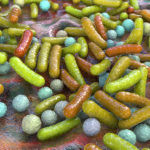By Bonnie Jenkins, Advanced Natural Wellness
With the threat of Severe Acute Respiratory Syndrome (SARS) looming worldwide, there could hardly be a better time to talk about the importance of a healthy immune system. It’s a popular topic in our household, since my daughter seems to catch every little bug that comes along. And, since we’re a pro-active bunch, our medicine cabinet is full of immune-boosting antioxidants and herbs. It’s made a world of difference.
The immune system is a wonderful and complex thing. Cells, biochemicals, organs and tissues work together to create an amazing shield that works day in and day out to protect you from disease. One of the extraordinary features of the immune system is its ability to respond to the environment – at least under normal circumstances. When the body is threatened by a toxin, bacteria or virus, a complex chain of physiological events begins and the immune system mounts an attack specifically designed to neutralize the invader. But a glitch in any of these components can cause the immune system to falter. And an immune system that isn’t working at its peak can leave you vulnerable to colds, flu, infection and even cancer.
Tough Enough
So how can you keep your immune system strong? One clue can be found in the work of Weston Price, D.D.S. A 1930’s-era dentist and world traveler, Weston noticed during his travels that the indigenous people of Peru, Africa, Australia and the Polynesian islands were remarkably free from disease. There was virtually no cancer, heart disease, osteoporosis, diabetes or any of the other ailments that commonly plagued the more civilized Western world. The common thread among these diverse cultures was that they all ate whole, unprocessed foods. Price also observed that when these natives were relocated to more modern areas – areas where refined foods were widely available – they began to suffer from the same diseases common in Europe and America.
Open your arteries, improve blood flow for a new health miracle...
Did you know your circulatory system has over 60,000 miles of arteries, veins and other blood vessels, if stretched end to end?
But as you age, your blood vessels undergo changes, which may cause them to stiffen, thicken and get clogged.
GOOD NEWS! Doctors have now identified a “Miracle Molecule” inside your arteries that helps OPEN your arteries and IMPROVE blood flow.
It’s what Dr. Valentin Fuster calls it, "One of the most important discoveries in the history of cardiovascular medicine."To you, that means...
- Healthy blood pressure
- Sharper mind and memory
- Skyrocketing energy and muscular strength
- Increased pleasure and passion in the bedroom
- Improved circulation to every cell and organ in your body
Go here to discover a new natural way to significantly boost the levels of this miracle molecule in YOUR body NOW!
I asked Elson Haas, M.D., about Price’s work. He said that wholesome, unprocessed foods are high in immune boosting antioxidants, particularly vitamins C and E, beta-carotene, zinc and selenium – which probably accounts for Price’s observations. But, since it’s hard to get optimal amounts of these nutrients in the typical American diet, it’s a good idea to supplement with a multi-vitamin/mineral compound. Dr. Haas also recommends taking extra vitamin C – between 4,000 and 10,000 mg. a day. He points out that vitamin C not only boosts antibody response and white blood cell function, it increases the production of interferon, the body’s first line of defense against infection.
Another common thread among indigenous cultures is that they rely almost exclusively on botanicals to maintain good health. But, because of medical science’s infatuation with synthetic drugs, word of these herbal medicines was kept under wraps for years. Fortunately a renewed interest in alternative health has lead to several exciting studies in the area of indigenous medicine. Among the herbs currently under investigation, two are proving to be spectacular immune boosters.
The World's Quickest Solution for Ending Prostate and Urinary Misery
This has recently been revealed to be one of the only real breakthroughs in prostate health.
The seeds of a strange fruit (sometimes called "Chinese Apples") hold powerful phytonutrients that are a revolution in prostate health.
In fact, UCLA and Veterans Administration research have now proved this to be true.
Not only that, but it may be the worlds quickest solution for ending prostate misery.
Simply stated, these phytonutrients represent a huge step beyond beta sitosterol, saw palmetto, and other phytosterols alone.
Simply click HERE if you want to have fast prostate relief...restful, uninterrupted sleep...no more constant "urges to go"...enhanced virility...and optimal prostate support for life.
Traditional Polynesian healers have used noni juice for more than 2,000 years as a health-promoting tonic. It’s not surprising, since recent studies have found that the polysaccharides in noni increase the release of immune-enhancing compounds that activate white blood cells. What really caught my attention, though, was a study by researcher at the University of Chicago’s College of Medicine in Rockford. During the study, noni displayed such strong antioxidant activity that it actually prevented the formation of cancer cells. That’s some serious immune protection.
Since noni juice is extremely bitter, commercial producers have altered the taste to make it more palatable and recommend drinking two tablespoons first thing in the morning. Personally, that’s not the way I want to start my day, so I did some snooping and found several manufacturers that make a powdered extract in capsule form.
A more recent immune stimulating discovery comes from the Amazon. Chuchuhuasi (pronounced “chew-chew-huh-wah-see”) is a Peruvian Indian remedy said to build immunity against just about anything that can attack the body. This seemed a little far-fetched to me, so I did some digging and found that, during the 1960’s, an American pharmaceutical company substantiated many of these traditional claims. According to their research, the leaf extract produced a potent stimulating effect on the immune system and increased phagocytosis, the process in which cells engulf and digest microorganisms and cellular debris.
In light of this research, I was surprised that no one had followed up on chuchuhuasi’s potential during the 70’s and 80’s. It wasn’t until recently that researchers began taking another look. This time, the focus has been on the herb’s ability to inhibit protein kinase C (PKC).Inhibitors of the PKC enzyme are of great interest today because there’s evidence the enzyme, in an over-active state, is involved in a wide array of disease processes. Among the diseases in which PKC may be overtly involved are rheumatoid arthritis, asthma, brain tumors, cancer, and cardiovascular disease.
One Last Thing . . .
I ran across an article in the Proceedings of the National Academy of Sciences this morning that seemed particularly timely. According to a new study, ordinary black tea can prime the immune system to attack invading bacteria, viruses and fungi. It seems that a compound in the tea called L-theanine breaks down to form a molecule that boosts the performance of gamma-delta T cells – which in turn stimulates the production of interferon. To test their theory on humans, 11 volunteers drank five cups of tea a day while 10 others consumed nothing but coffee. At the end of four weeks, the teetotalers had five times more interferon in their blood than the coffee drinkers.
The importance of a healthy immune system can’t be underestimated. Whether you are sick and want to get better or are healthy and want to stay that way, these natural solutions can supercharge your immunity.
References:
Arati B, et al. “Antigens in tea-beverage prime human V ﻻ2V 2T cells in vitro and in vivo for memory and nonmemory antibacterial cytokine responses.” Proceedings of the National Academy of Sciences. 2003; 100.
Bradshaw D. et al. “Therapeutic Potential of Protein Kinase C Inhibitors.” Agents and Actions. 1993; 38: 135-147.
DiCarlo, F. J. et al., “Reticuloendothelial System Stimulants of Botanical Origin,” Journal of the Reticuloendothelial Society. 1964: 224-232.
Hirazumi A, et al. “An immunomodulatory polysaccharide-rich substance from the fruit juice of Morinda citrifolia (noni) with antitumor activity.” Phytotherapy Research. 1999; 13: 380-387.
Wang MY, et al. “Cancer preventive effect of Morinda citrifolia (Noni).” Annals of the New York Academy of Sciences. 2001; 952: 161-168






